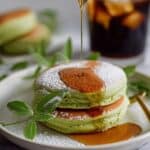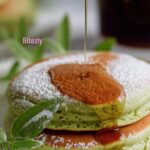Matcha Soufflé Pancakes Recipe
These Matcha Soufflé Pancakes are irresistibly airy and fluffy, giving you a cloud-like texture infused with the delicate flavor of Japanese green tea powder. Perfect for a Sunday brunch, these pancakes are topped with homemade whipped cream, maple syrup, and an extra dusting of matcha powder for a beautiful, flavorful breakfast treat.
- Prep Time: 15 minutes
- Cook Time: 15 minutes
- Total Time: 30 minutes
- Yield: 3 pancakes (3-inch each)
- Category: Breakfast
- Method: Frying
- Cuisine: Japanese
- Diet: Vegetarian
Ingredients
Matcha Soufflé Pancakes
- 2 large eggs (50 g each without shell)
- 2 Tbsp whole milk
- ¼ tsp pure vanilla extract
- 30 g cake flour (¼ cup minus 1 tsp; sifted)
- 1 tsp matcha (green tea powder) (2 g)
- ½ tsp baking powder (1 g)
- 2 Tbsp sugar
- 1 Tbsp neutral oil
- 2 Tbsp water (for steaming)
Fresh Whipped Cream (optional)
- ½ cup heavy (whipping) cream
- 1½ Tbsp sugar
Toppings
- 1 Tbsp confectioners’ sugar
- Maple syrup
- Fresh berries (strawberries, blueberries, etc.; optional)
Instructions
- Prepare the whipped cream (optional): Set an ice bath by filling a large bowl with ice water and resting a medium bowl on top. Add ½ cup heavy cream and 1½ Tbsp sugar to the cold bowl. Whisk at high speed until medium to firm peaks form. Keep chilled until serving.
- Separate eggs and chill whites: Separate the 2 eggs into yolks and whites. Place egg whites into a bowl and freeze for 15 minutes to partially freeze them, which helps achieve a perfect meringue.
- Mix egg yolk batter: Add 2 Tbsp whole milk and ¼ tsp vanilla extract to yolks. Whisk until thick and frothy. Sift together 30 g cake flour, 1 tsp matcha powder, and ½ tsp baking powder, then whisk into the yolk mixture until just combined. Avoid overmixing.
- Make the meringue: Remove egg whites from freezer (should be half frozen). Beat on medium-low until frothy, gradually adding 2 Tbsp sugar in thirds. Increase speed to high and beat to stiff peaks—glossy texture and peaks that stand straight or slightly fold at tips.
- Heat frying pan: Warm a 12-inch nonstick skillet over the lowest heat setting until the surface reaches 300ºF (150ºC). Brush lightly with 1 Tbsp neutral oil, then wipe excess with a paper towel to avoid spotty frying.
- Combine meringue and batter: Fold one-third of the meringue into the yolk mixture by whisking to lighten. Gently fold half of remaining meringue using a whisk to retain air bubbles. Finally, fold in the rest of the meringue gently until fully combined and smooth.
- Form pancakes: Keep pan heated at 300ºF (150ºC) on low. Using a ladle (~2–3 Tbsp), pile batter into tall mounds—start with two scoops per pancake for three pancakes. Add a third scoop once the surface feels slightly dry.
- Steam cook pancakes: Add 1 Tbsp water into three empty pan spaces and cover with a lid. Cook for 6–7 minutes on low heat to steam and set the pancakes. After 2 minutes, add a final scoop on each pancake to build height. Add more water if evaporated and cover.
- Flip pancakes: After 6–7 minutes, gently loosen and flip each pancake using a rolling motion with an offset spatula. Add another 1 Tbsp water to empty pan spots, cover, and cook the other side for 4–5 minutes on lowest heat.
- Serve: Plate pancakes and top with fresh whipped cream, fresh berries, a dusting of confectioners’ sugar and matcha powder, and drizzle maple syrup. Enjoy immediately for best texture.
- Store leftovers: Store pancakes in an airtight container in the refrigerator for up to 2 days. Reheat gently to avoid deflating.
Notes
- Use the fluff and sprinkle method or weigh flour for accuracy to avoid dense pancakes.
- Partially freezing egg whites helps create a stable meringue for fluffy texture.
- Beat egg whites to stiff peaks but avoid overbeating, which can cause graininess and deflation.
- Cook pancakes slowly over low heat with steaming water to keep them moist and prevent collapsing.
- Do not rush flipping; wait until pancakes can be gently moved to avoid cracks.
- Best eaten fresh; stored leftovers may lose fluffiness.
Find it online: http://bitezly.com/matcha-souffle-pancakes-recipe/

